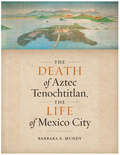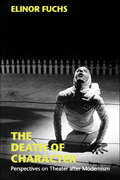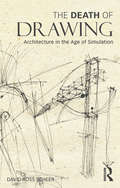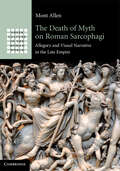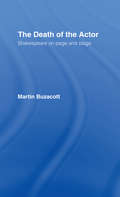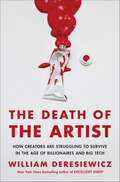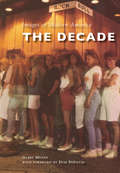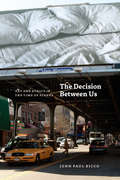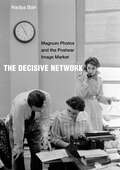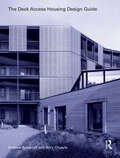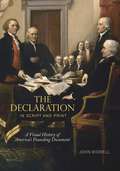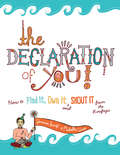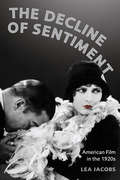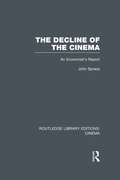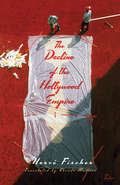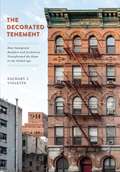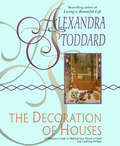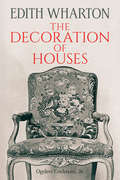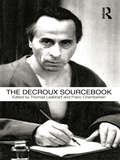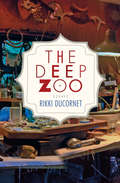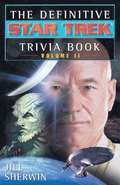- Table View
- List View
The Death of Aztec Tenochtitlan, the Life of Mexico City (Joe R. and Teresa Lozano Long Series in Latin American and Latino Art and Culture)
by Barbara E. MundyThe capital of the Aztec empire, Tenochtitlan, was, in its era, one of the largest cities in the world. Built on an island in the middle of a shallow lake, its population numbered perhaps 150,000, with another 350,000 people in the urban network clustered around the lake shores. In 1521, at the height of Tenochtitlan&’s power, which extended over much of Central Mexico, Hernando Cortés and his followers conquered the city. Cortés boasted to King Charles V of Spain that Tenochtitlan was &“destroyed and razed to the ground.&” But was it? Drawing on period representations of the city in sculptures, texts, and maps, The Death of Aztec Tenochtitlan, the Life of Mexico City builds a convincing case that this global capital remained, through the sixteenth century, very much an Amerindian city. Barbara E. Mundy foregrounds the role the city&’s indigenous peoples, the Nahua, played in shaping Mexico City through the construction of permanent architecture and engagement in ceremonial actions. She demonstrates that the Aztec ruling elites, who retained power even after the conquest, were instrumental in building and then rebuilding the city. Mundy shows how the Nahua entered into mutually advantageous alliances with the Franciscans to maintain the city's sacred nodes. She also focuses on the practical and symbolic role of the city&’s extraordinary waterworks—the product of a massive ecological manipulation begun in the fifteenth century—to reveal how the Nahua struggled to maintain control of water resources in early Mexico City.
The Death of Character: Perspectives on Theater after Modernism (Drama and Performance Studies)
by Elinor Fuchs"Extremely well written, and exceedingly well informed, this is a work that opens a variety of important questions in sophisticated and theoretically nuanced ways. It is hard to imagine a better tour guide than Fuchs for a trip through the last thirty years of, as she puts it, what we used to call the 'avant-garde.'" —Essays in Theatre". . . an insightful set of theoretical 'takes' on how to think about theatre before and theatre after modernism." —Theatre Journal"In short, for those who never experienced a 'postmodern swoon,' Elinor Fuchs is an excellent informant." —Performing Arts Journal". . . a thoughtful, highly readable contribution to the evolving literature on theatre and postmodernism." —Modern Drama"A work of bold theoretical ambition and exceptional critical intelligence. . . . Fuchs combines mastery of contemporary cultural theory with a long and full participation in American theater culture: the result is a long-needed, long-awaited elaboration of a new theatrical paradigm." —Una Chaudhuri, New York University"What makes this book exceptional is Fuchs' acute rehearsal of the stranger unnerving events of the last generation that have—in the cross-reflections of theory—determined our thinking about theater. She seems to have seen and absorbed them all." —Herbert Blau, Center for Twentieth Century Studies, University of Wisconsin, Milwaukee"Surveying the extraordinary scene of the postmodern American theater, Fuchs boldly frames key issues of subjectivity and performance with the keenest of critical eyes for the compelling image and the telling gesture." —Joseph Roach, Tulane University" . . . Fuchs makes an exceptionally lucid and eloquent case for the value and contradictions in postmodern theater." —Alice Rayner, Stanford University"Arguably the most accessible yet learned road map to what remains for many impenetrable territoryan obligatory addition to all academic libraries serving upper-division undertgraduates and above." —Choice"A systematic, comprehensive and historically-minded assessment of what, precisely, 'post-modern theatre' is, anyway." —American TheatreIn this engrossing study, Elinor Fuchs explores the multiple worlds of theater after modernism. While The Death of Character engages contemporary cultural and aesthetic theory, Elinor Fuchs always speaks as an active theater critic. Nine of her Village Voice and American Theatre essays conclude the volume. They give an immediate, vivid account of contemporary theater and theatrical culture written from the front of rapid cultural change.
The Death of Drawing: Architecture in the Age of Simulation
by David Ross ScheerThe Death of Drawing explores the causes and effects of the epochal shift from drawing to computation as the chief design and communication medium in architecture. Drawing both framed the thinking of architects and organized the design and construction process to place architects at its center. Its displacement by building information modeling (BIM) and computational design recasts both the terms in which architects think and their role in building production. Author David Ross Scheer explains that, whereas drawing allowed architects to represent ideas in form, BIM and computational design simulate experience, making building behavior or performance the primary object of design. The author explores many ways in which this displacement is affecting architecture: the dominance of performance criteria in the evaluation of design decisions; the blurring of the separation of design and construction; the undermining of architects’ authority over their projects by automated information sharing; the elimination of the human body as the common foundation of design and experience; the transformation of the meaning of geometry when it is performed by computers; the changing nature of design when it requires computation or is done by a digitally-enabled collaboration. Throughout the book, Scheer examines both the theoretical bases and the practical consequences of these changes. The Death of Drawing is a clear-eyed account of the reasons for and consequences of the displacement of drawing by computational media in architecture. Its aim is to give architects the ability to assess the impact of digital media on their own work and to see both the challenges and opportunities of this historic moment in the history of their discipline.
The Death of Myth on Roman Sarcophagi: Allegory and Visual Narrative in the Late Empire (Greek Culture in the Roman World)
by Mont AllenA strange thing happened to Roman sarcophagi in the third century: their Greek mythic imagery vanished. Since the beginning of their production a century earlier, these beautifully carved coffins had featured bold mythological scenes. How do we make sense of this imagery's own death on later sarcophagi, when mythological narratives were truncated, gods and heroes were excised, and genres featuring no mythic content whatsoever came to the fore? What is the significance of such a profound tectonic shift in the Roman funerary imagination for our understanding of Roman history and culture, for the development of its arts, for the passage from the High to the Late Empire and the coming of Christianity, but above all, for the individual Roman women and men who chose this imagery, and who took it with them to the grave? In this book, Mont Allen offers the clues that aid in resolving this mystery.
The Death of the Actor: Shakespeare on Page and Stage
by Martin BuzacottIn The Death of the Actor Martin Buzacott launches an all-out attack on contemporary theatrical practice and performance theory which identifies the actor, rather than the director, as the key creative force in the performance of Shakespeare. Because actors are absent from the site of Shakespearean meaning, he argues, the illusion of their centrality is sustained only by a rhetoric of heroism, violence and imperialism.
The Death of the Artist: How Creators Are Struggling to Survive in the Age of Billionaires and Big Tech
by William DeresiewiczA deeply researched warning about how the digital economy threatens artists' lives and work—the music, writing, and visual art that sustain our souls and societies—from an award-winning essayist and criticThere are two stories you hear about earning a living as an artist in the digital age. One comes from Silicon Valley. There's never been a better time to be an artist, it goes. If you've got a laptop, you've got a recording studio. If you've got an iPhone, you've got a movie camera. And if production is cheap, distribution is free: it's called the Internet. Everyone's an artist; just tap your creativity and put your stuff out there.The other comes from artists themselves. Sure, it goes, you can put your stuff out there, but who's going to pay you for it? Everyone is not an artist. Making art takes years of dedication, and that requires a means of support. If things don't change, a lot of art will cease to be sustainable.So which account is true? Since people are still making a living as artists today, how are they managing to do it? William Deresiewicz, a leading critic of the arts and of contemporary culture, set out to answer those questions. Based on interviews with artists of all kinds, The Death of the Artist argues that we are in the midst of an epochal transformation. If artists were artisans in the Renaissance, bohemians in the nineteenth century, and professionals in the twentieth, a new paradigm is emerging in the digital age, one that is changing our fundamental ideas about the nature of art and the role of the artist in society.
The Decade (Images of Modern America)
by Gabby Means Dom DisilvioThe Decade was the birthplace of rock 'n' roll in Pittsburgh, at the corner of Atwood and Sennott. The eclectic bar with parachutes covering the ceiling was home base for local bands such as the Iron City Houserockers, but it also served as a showcase for rising international recording acts, including the Police, U2, the Red Hot Chili Peppers, and the Ramones. Under the shadow of the University of Pittsburgh, The Decade was an oasis of live rock and blues music in the 1970s to the early 1990s. The small venue had wide appeal to bands who felt they could intimately connect with their audience. Owned and operated by Dom DiSilvio, The Decade will forever be a home to many Pittsburghers, and Images of Modern America: The Decade is a home for their stories.
The Decision Between Us: Art and Ethics in The Time of Scenes
by John Paul RiccoThe Decision Between Us combines an inventive reading of Jean-Luc Nancy with queer theoretical concerns to argue that while scenes of intimacy are spaces of sharing, they are also spaces of separation. John Paul Ricco shows that this tension informs our efforts to coexist ethically and politically, an experience of sharing and separation that informs any decision. Using this incongruous relation of intimate separation, Ricco goes on to propose that "decision” is as much an aesthetic as it is an ethical construct, and one that is always defined in terms of our relations to loss, absence, departure, and death. Laying out this theory of "unbecoming community” in modern and contemporary art, literature, and philosophy, and calling our attention to such things as blank sheets of paper, images of unmade beds, and the spaces around bodies, The Decision Between Us opens in 1953, when Robert Rauschenberg famously erased a drawing by Willem de Kooning, and Roland Barthes published Writing Degree Zero, then moves to 1980 and the "neutral mourning” of Barthes’ Camera Lucida, and ends in the early 1990s with installations by Felix Gonzalez-Torres. Offering surprising new considerations of these and other seminal works of art and theory by Jean Genet, Marguerite Duras, and Catherine Breillat, The Decision Between Us is a highly original and unusually imaginative exploration of the spaces between us, arousing and evoking an infinite and profound sense of sharing in scenes of passionate, erotic pleasure as well as deep loss and mourning.
The Decision Between Us: Art and Ethics in the Time of Scenes
by John Paul RiccoThe Decision Between Us combines an inventive reading of Jean-Luc Nancy with queer theoretical concerns to argue that while scenes of intimacy are spaces of sharing, they are also spaces of separation. John Paul Ricco shows that this tension informs our efforts to coexist ethically and politically, an experience of sharing and separation that informs any decision. Using this incongruous relation of intimate separation, Ricco goes on to propose that “decision” is as much an aesthetic as it is an ethical construct, and one that is always defined in terms of our relations to loss, absence, departure, and death. Laying out this theory of “unbecoming community” in modern and contemporary art, literature, and philosophy, and calling our attention to such things as blank sheets of paper, images of unmade beds, and the spaces around bodies, The Decision Between Us opens in 1953, when Robert Rauschenberg famously erased a drawing by Willem de Kooning, and Roland Barthes published Writing Degree Zero, then moves to 1980 and the “neutral mourning” of Barthes’ Camera Lucida, and ends in the early 1990s with installations by Felix Gonzalez-Torres. Offering surprising new considerations of these and other seminal works of art and theory by Jean Genet, Marguerite Duras, and Catherine Breillat, The Decision Between Us is a highly original and unusually imaginative exploration of the spaces between us, arousing and evoking an infinite and profound sense of sharing in scenes of passionate, erotic pleasure as well as deep loss and mourning.
The Decisive Network: Magnum Photos and the Postwar Image Market
by Nadya BairSince its founding in 1947, the legendary Magnum Photos agency has been telling its own story about photographers who were witnesses to history and artists on the hunt for decisive moments. Based on unprecedented archival research, The Decisive Network unravels Magnum’s mythologies to offer a new history of what it meant to shoot, edit, and sell news images after World War II. Nadya Bair shows that between the 1940s and 1960s, Magnum expanded the human-interest story to global dimensions while bringing the aesthetic of news pictures into new markets. Working with a vast range of editorial and corporate clients, Magnum made photojournalism integral to postwar visual culture. But its photographers could not have done this alone. By unpacking the collaborative nature of photojournalism, this book shows how picture editors, sales agents, spouses, and publishers helped Magnum photographers succeed in their assignments and achieve fame. Bair concludes in the late 1960s and early 1970s, when changing market conditions led Magnum to consolidate its brand. In that moment, Magnum’s photojournalists became artists and their assignments oeuvres. Bridging art history, media studies, cultural history, and the history of communication, The Decisive Network transforms our understanding of the photographic profession and the global circulation of images in the predigital world.
The Deck Access Housing Design Guide: A Return to Streets in the Sky
by Andrew Beharrell Rory OlcaytoThe Deck Access Housing Design Guide is the first practical design guide to deck access housing. It focuses on the contemporary use of deck access housing, sharing practical guidance and providing in-depth case studies, while also presenting historical context about this flexible and evolving housing type. Despite a chequered history that saw it linked with urban decay and social malaise in the 1970s and 80s, deck access housing today, after a 40-year hiatus, is fast becoming the default solution for mid-rise housing in the UK, and London in particular. This is in part down to architects’ renewed interest in post-war Modernist typologies, but also due to specific planning standards that favour the qualities – dual-aspect plans, ‘public’ front doors – of deck access design. This comprehensive, professional guide spotlights the best contemporary deck access housing in the UK and throughout mainland Europe, explaining and analysing exemplars in detail. Illustrated in full colour throughout with plans, elevations, photographs, project data and annotations, case studies include both new build and retrofit projects, in public housing, co-housing and Third Age residential projects. Good architectural practice flows from an informed understanding of cultural and design history coupled with practical guidance and clear analysis of case studies. That is what this book provides for anyone interested in, or involved in the design and delivery of, deck access housing. Featured architects from the UK: AHMM · Apparata · Cartwright Pickard · Collective Architecture · DO Architecture · Hawkins Brown · Haworth Tompkins · Henley Halebrown · Levitt Bernstein · Maccreanor Lavington · Mæ · Matthew Lloyd · Pitman Tozer · Pollard Thomas Edwards · Proctor & Matthews · PRP · RCKa Featured architects from mainland Europe: ANMA · Arquitectura Produccions · Atelier Kempe Thill · Bureau Massa · DAMAST · Estudio Herreros · Fink + Jocher · KAAN · LEVS · Martin-Löf · MEF · Muñoz Miranda · Passelac & Roques · Waechter + Waechter
The Declaration in Script and Print: A Visual History of America’s Founding Document (Penn State Series in the History of the Book)
by John BidwellPerhaps the single most important founding document of the United States of America, the Declaration of Independence became both a work of art and a mass-market commodity during the nineteenth century. In this book, graphic arts historian John Bidwell traces the fascinating history of Declaration prints and broadsides and reveals the American public’s changing attitudes toward this iconic text.The new and improved intaglio, letterpress, and lithographic printing technologies of the nineteenth century led to increasingly elaborate reproductions of the Declaration. Some were touted as precious relics; others were aimed at the bottom of the market. Rival publishers claimed to have produced the definitive visualization of the document, attacking the character and patriotism of other firms even as they promoted their own artistic abilities and attention to detail. Meanwhile, painter John Trumbull attempted to sell subscriptions for an engraved version of his Declaration painting, and John Quincy Adams—then secretary of state—commissioned an official 1823 edition in response to the feuding facsimilists seeking government patronage. Bidwell unravels the intricate web of rivalries surrounding these competing publications.Featuring a comprehensive checklist of nearly two hundred prints and broadsides drawn from various collections, this engrossing history highlights the proliferation and widespread influence of the Declaration of Independence on American popular culture. It will be equally esteemed by general readers interested in American history, print and autograph collectors, and art and book historians.
The Declaration of Cartoon Independents!: The Channel Frederator & Cartoon Hangover Selected Postcards 2008-2015
by Matt Gielen Fred SeibertMore than 120 full color postcard illustrations from the leading online animation network. Over the past 10 years, Channel Frederator's become the world's biggest animation network, built, film by film, by thousands of animators across the globe. Each of the creators completely controls their own channel, makes all their own decisions. There are no filters, no gatekeepers, no barriers to the expressions of these intrepid souls. Just the raw, direct, and often sophisticated moving picture expressions of the characters they love, the worlds they inhabit, and the stories they tell.
The Declaration of You!: How to Find It, Own It and Shout It From the Rooftops
by Jessica Swift Michelle WardDiscover Your Purpose! It's time to shed your "shoulds," and give yourself permission to step powerfully into your own passionate life. Through a series of creative, colorful exercises--questions to get the wheels turning and an encouraging kick in the pants--you will get all the loving support you need to discover how you are unique and uncover what you are meant to do! Discover It (list-making explorations), Own It (inspiring interviews with highly successful individuals) and Make It (fun and crafty projects) sections offer an in-depth look at who you are and the amazing places you'll go. Every life topic is explored here: Enthusiasm, Celebration, Uniquity, Trust, Intention, Self-Care, Success and Money, so you know Jess and Michelle have you covered! Self-affirming declarations in each chapter keep you motivated while you discover more and more about the wonderful person you are. It's time to see a new perspective. It's time to find The Declaration of You!
The Decline of Sentiment: American Film in the 1920s
by Lea JacobsThe Decline of Sentiment seeks to characterize the radical shifts in taste that transformed American film in the jazz age. Based upon extensive reading of trade papers and the popular press of the day, Lea Jacobs documents the films and film genres that were considered old-fashioned, as well as those dubbed innovative and up-to-date, and looks closely at the works of filmmakers such as Erich von Stroheim, Charlie Chaplin, Ernst Lubitsch, and Monta Bell, among many others. Her analysis--focusing on the influence of literary naturalism on the cinema, the emergence of sophisticated comedy, and the progressive alteration of the male adventure story and the seduction plot--is a comprehensive account of the modernization of classical Hollywood film style and narrative form.
The Decline of the Cinema: An Economist’s Report (Routledge Library Editions: Cinema)
by John SpraosBetween 1952 and 1962, when this book was originally published, the number of people visiting British cinemas had fallen by nearly two thirds and was little more than half the pre-war total. Nearly 1500 of the 4500 cinemas functioning in 1955 had closed five years later, and the author here predicts a further substantial fall. The causes of this drastic decline are traced to the competition of television but also to the dramatic halving of the number of new American films and to the difficulty of transferring a cinema’s ‘congregation’ when it is closed. This decline has few parallels in recent times and in conjunction with a disproportionate and unexpected increase in the price of seats presents a fascinating study for the economist, which the author fully exploits. But the film industry is of general interest so that the author’s conclusions and his social recommendations will appeal to the general reader as well as those in the industry.
The Decline of the Hollywood Empire
by Hervé FischerThe Hollywood empire was built over the course of a century through hard-nosed business practices such as block booking, dumping and buying up the competition, turning the silver screen into a goldmine in the process. The business logic that has driven the industry since its beginnings has gone into hyperdrive in recent years, with astronomical sums invested in productions and promotion. Ironically that massive outlay has gone toward churning out a flat, made-in-Hollywood universalism that can be exported planet-wide, but which is simultaneously losing audiences, primarily to the digital world, at an accelerating pace. The apparently insurmountable barriers of finance and distribution to entry into the world of entertainment have served, so far, to keep smaller players out of the frame and, Fischer contends, have destroyed the industry's creative potential. It turns out too much money can kill cinema just as certainly as not enough. In The Decline of the Hollywood Empire, artist and philosopher Hervé Fischer heralds an inevitable move from 35 mm to digital distribution, which will take what has until now existed only on the margins of the "entertainment industry"--independent film, amateur film, documentary and other genres--from bit players to starring roles: how the Trojan horse of digital technology and distribution, in the hands of independent producers, could well toll the bell for Hollywood's hegemony in the business of film.
The Decorated Tenement: How Immigrant Builders and Architects Transformed the Slum in the Gilded Age
by Zachary J. VioletteWinner of the International Society of Place, Landscape, and Culture Fred B. Kniffen AwardA reexamination of working-class architecture in late nineteenth-century urban AmericaAs the multifamily building type that often symbolized urban squalor, tenements are familiar but poorly understood, frequently recognized only in terms of the housing reform movement embraced by the American-born elite in the late nineteenth century. This book reexamines urban America&’s tenement buildings of this period, centering on the immigrant neighborhoods of New York and Boston. Zachary J. Violette focuses on what he calls the &“decorated tenement,&” a wave of new buildings constructed by immigrant builders and architects who remade the slum landscapes of the Lower East Side of Manhattan and the North and West Ends of Boston in the late nineteenth century. These buildings&’ highly ornamental facades became the target of predominantly upper-class and Anglo-Saxon housing reformers, who viewed the facades as garish wrappings that often hid what they assumed were exploitative and brutal living conditions. Drawing on research and fieldwork of more than three thousand extant tenement buildings, Violette uses ornament as an entry point to reconsider the role of tenement architects and builders (many of whom had deep roots in immigrant communities) in improving housing for the working poor.Utilizing specially commissioned contem-porary photography, and many never-before-published historical images, The Decorated Tenement complicates monolithic notions of architectural taste and housing standards while broadening our understanding of the diversity of cultural and economic positions of those responsible for shaping American architecture and urban landscapes. Winner of the International Society of Place, Landscape, and Culture Fred B. Kniffen Award
The Decoration of Houses
by Alexandra StoddardAlexandra Stoddard continues her creative and insightful guidance by showing us how to make our homes a real expression of our true selves. Starting with the Fifteen Defining Principles of Interior Design, Stoddard grounds us in the classic standards that make any home timeless and follows with inventive suggestions. Her own bold ideas about color, pattern, and texture are affordable tips from her own vast experience involving every imaginable decoration problem. From lighting a room to adding fabrics, furnishings, and the perfect finishing touches, she offers her expertise while always encouraging us to listen to our inner voice for the final answer.
The Decoration of Houses (Dover Architecture)
by Edith Wharton Ogden Codman Jr.Thousands of books on interior design have come and gone since the 1897 publication of this pioneering manual, but The Decoration of Houses remains, thanks to the insightful and inspiring advice of its co-authors. Before she became the Pulitzer Prize-winning author of The Age of Innocence, Edith Wharton was a society matron, remodeling a summer home in Newport, Rhode Island. With the able assistance of architect Ogden Codman, Jr., Wharton assembled this corrective to the rampant vulgarity of her nouveau riche neighbors. Wharton and Codman defied the excesses of the Gilded Age, counseling readers to reject the popular penchant for clutter in favor of simplicity and balance.More than an engaging item of period charm, this historic guide offers examples of design rooted in architectural principles. Black-and-white photographs illustrate the authors' ideals of classic beauty, depicting grand ballrooms and spacious boudoirs as well as the elements common to homes of every size and era: doors and windows, walls and ceilings, floors, halls, and stairs. One of the genre's most important and influential titles, this volume sparked a Renaissance in American interior design, and its sound advice and practical approach remain forever in style.
The Decroux Sourcebook
by Franc Chamberlain Thomas LeabhartThe Decroux Sourcebook is the first point of reference for any student of the ‘hidden master’ of twentieth century theatre. This book collates a wealth of key material on Etienne Decroux, including: an English translation of Patrice Pezin’s ‘Imaginary Interview’, in which Decroux discusses mime’s place in the theatre. previously unpublished articles by Decroux from France’s Bibiothèque Nationale. essays from Decroux’s fellow innovators Eugenio Barba and Edward Gordon Craig, explaining the synthesis of theory and practice in his work. Etienne Decroux’s pioneering work in physical theatre is here richly illustrated not only by a library of source material, but also with a gallery of images following his life, work and influences. The Decroux Sourcebook is an ideal companion to Thomas Leabhart’s Etienne Decroux in the Routledge Performance Practitioners series, offering key primary and secondary resources to those conducting research at all levels.
The Deep Zoo: Essays
by Rikki DucornetIncluded in Library Journal's "25 Key Indie Fiction Titles, Fall 2014-Winter 2015"Within the writer's life, words and things acquire power. For Borges it is the tiger and the color red, for Cortázar a pair of amorous lions, and for an early Egyptian scribe the monarch butterfly that metamorphosed into the Key of Life. Ducornet names these powers The Deep Zoo. Her essays take us from the glorious bestiary of Aloys Zötl to Abu Ghraib, from the tree of life to Sade's Silling Castle, from The Epic of Gilgamesh to virtual reality. Says Ducornet, "To write with the irresistible ink of tigers and the uncaging of our own Deep Zoo, we need to be attentive and fearless-above all very curious-and all at the same time.""Ducornet's skill at drawing unexpected connections, and her ability to move between outrage and meditativeness, are gripping to behold."-Star Tribune"This collection of essays meditates on art, mysticism, and more; it'll leave a reader with plenty to ponder."-Vol. 1 Brooklyn"Rikki Ducornet's new collection The Deep Zoo is filled with smart and surprising essays that explore our connections to the world through art."-Largehearted Boy""The Deep Zoo" acts as a kind of foundational text, a lens to view her work and the other essays through. . . Subversive at heart and acutely perceptive."-Numero Cinq"Ducornet moves between these facets of human experience with otherworldly grace, creating surprising parallels and associations. . . The Deep Zoo is a testament to her acrobatic intelligence and unflinching curiosity. Ducornet not only trusts the subconscious, she celebrates and interrogates it."-The Heavy Feather"What struck me most about this collection, and what I am confident will pull me back to it again, is Ducornet's obvious passion for life. She is . . . attentive, fearless, and curious. And for a hundred pages we get to see how it feels to exist like that, what it's like to think critically and still be open to the world."-Cleaver Magazine"Rikki Ducornet is imagination's emissary to this mundane world."-Stephen Sparks, Green Apple Books on the Park"This book is like the secret at the heart of the world; I've put other books aside."-Anne GermanacosPraise for Rikki Ducornet"A novelist whose vocabulary sweats with a kind of lyrical heat."-The New York Times"Linguistically explosive . . . one of the most interesting American writers around."-The Nation"Ducornet-surrealist, absurdist, pure anarchist at times-is one of our most accomplished writers, adept at seizing on the perfect details and writing with emotion and cool detachment simultaneously."-Jeff Vandermeer"A unique combination of the practical and fabulous, a woman equally alive to the possibilities of joy and the necessity of political responsibility, a creature-à la Shakespeare's Cleopatra-of 'infinite variety,' Ducornet is a writer of extraordinary power, in whose books 'rigor and imagination' (her watchwords) perform with the grace and daring of high-wire acrobats."-Laura Mullen, BOMB Magazine"The perversity, decadence, and even the depravity that Ducornet renders here feel explosively fresh because their sources are thought and emotion, not the body, and finally there's some pathos too."-The Boston Globe"Ducornet's skill at drawing unexpected connections, and her ability to move between outrage and meditativeness, are gripping to behold."-Tobias Carroll, Star Tribune"This collection of essays meditates on art, mysticism, and more; it'll leave a reader with plenty to ponder."- Vol. 1 Brooklyn"Rikki Ducornet's new collection The Deep Zoo is filled with smart and surprising essays that explore our connections to the world through art."- Largehearted Boy
The Definitive Star Trek Trivia Book: Star Trek All Series (Star Trek)
by Richard Oriolo Jill SherwinSO YOU THINK YOU KNOW STAR TREK? WELL, FIRE UP THOSE NEURONS, BECAUSE HERE'S YOUR CHANCE TO PROVE IT!-- 1 How many tribbles did Spock calculate had bred aboard Deep Space Station K-7?_____________________________-- 2 What type of life-form was the Caretaker?A. Sporocystian B. Solanagen C. Silicon D. Unidentifiable-- 3 In which episode is a deaf mediator the key to ending a war that has persisted for fifteen centuries?______________________________-- 4 Identify each species: A. __________B. __________C. __________-- 5 Match the ship with its appropriate registry number: A. U. S. S. Voyageri. NX-74205B. U. S. S. Defiantii. NX-2000C. U. S. S. Pegasusiii. NCC-74656D. U. S. S. Excelsioriv. NCC-53847-- 6 Name: A. Sulu's daughter _____________B. Troi's older sister _____________C. Kira's father _____________D. Tuvok's wife _____________The answers to those questions and many others are just pages away in THE DEFINITIVE STAR TREK TRIVIA BOOK, the ultimate collection of memory testers, brainteasers, and mind-bending minutiae from thirty-four years of movies and TV series. Nearly three thousand fill-in-the-blanks, multiple-choice questions, and matching questions are organized into themed chapters such as "Galactic History", "About the Crews", "Alien Species", "Star Trek Science", and "Command Questions". This jam-packed, fun-filled illustrated trivia book is just what devoted Star Trek fans have always wanted: the means to test themselves and one another on one of the richest and most complex fictional universes ever created. -- See reverse side for the answers!
The Dehumanization of Art and Other Essays on Art, Culture, and Literature
by José Ortega y GassetA classic work on radical aesthetics by one of the great philosophers of the early twentieth century No work of philosopher and essayist José Ortega y Gasset has been more frequently cited, admired, or criticized than his response to modernism, “The Dehumanization of Art.” The essay, originally published in Spanish in 1925, grappled with the newness of nonrepresentational art and sought to make it more understandable to the public. Many embraced the essay as a manifesto extolling the virtues of vanguard artists and promoting efforts to abandon the realism and the romanticism of the nineteenth century. Others took it as a denunciation of everything that was radical about the avant-garde. This Princeton Classics edition makes this essential work, along with four of Ortega’s other critical essays, available in English. A new foreword by Anthony J. Cascardi considers how Ortega’s philosophy remains relevant and significant in the twenty-first century.
The Demand for International Football Telecasts in the United States
by Tim Pawlowski Georgios NalbantisThis book provides a comprehensive overview and economic analysis of US consumer demand for televised football (soccer). Accounting for transnational demand, research is focused on the US consumers demand for the English Premier League, Spanish La Liga, Italian Serie A, German Bundesliga, French Ligue 1 and the UEFA Champions League, which represent the most popular and marketable football competitions worldwide, and have recently sealed lucrative media rights contracts in many large markets, including the US. The study also takes account of North American Major League Soccer (MLS) in order to provide a more comprehensive overview of the country's football market and to allow for direct comparisons with the aforementioned European competitions. These findings offer valuable insights for US broadcasters, European league organizers and managers to adjust existing strategies and/or develop new strategies in conquering the US football market.
